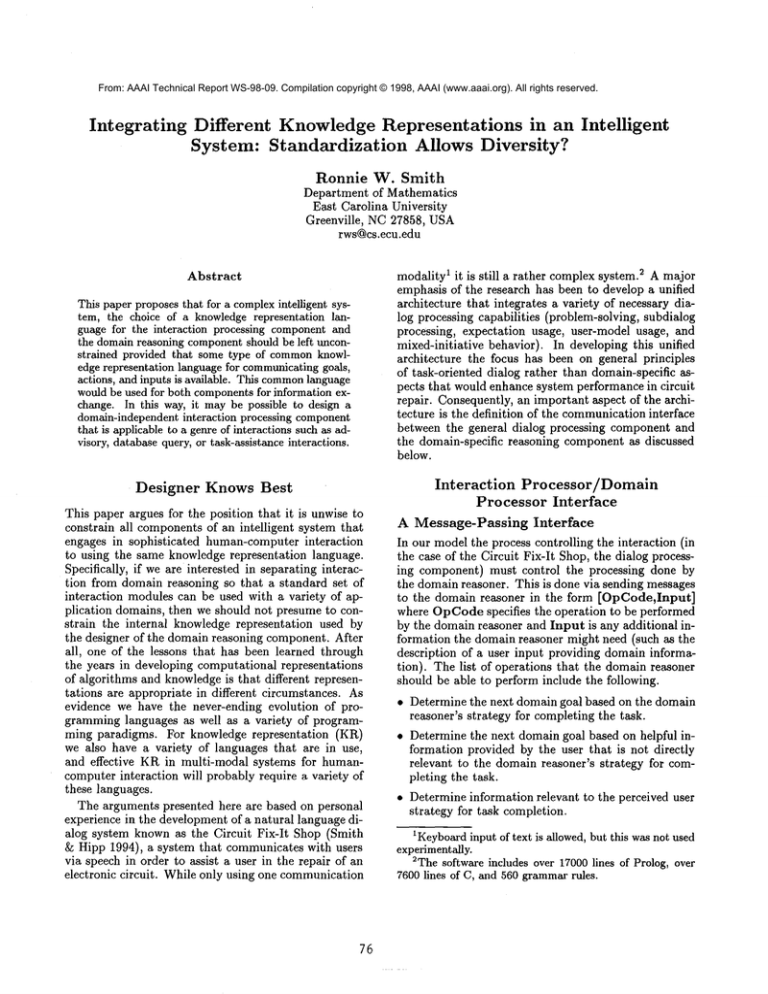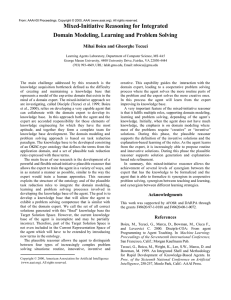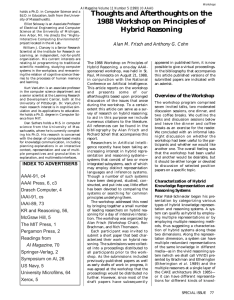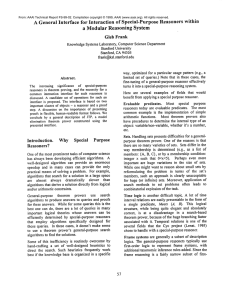
From: AAAI Technical Report WS-98-09. Compilation copyright © 1998, AAAI (www.aaai.org). All rights reserved.
Integrating
Different
Knowledge Representations
in an Intelligent
System: Standardization
Allows Diversity?
Ronnie W. Smith
Department of Mathematics
East Carolina University
Greenville, NC 27858, USA
rws@cs.ecu.edu
Abstract
This paper proposesthat for a complexintelligent system, the choice of a knowledgerepresentation language for the interaction processing componentand
the domainreasoning componentshould be left unconstrained provided that some type of commonknowledge representation language for communicating
goals,
actions, and inputs is available. This common
language
wouldbe used for both componentsfor information exchange. In this way, it maybe possible to design a
domain-independentinteraction processing component
that is applicable to a genre of interactions such as advisory, database query, or task-assistance interactions.
Designer
Knows
Best
This paper argues for the position that it is unwise to
constrain all components of an intelligent system that
engages in sophisticated human-computer interaction
to using the same knowledge representation language.
Specifically, if we are interested in separating interaction from domain reasoning so that a standard set of
interaction modules can be used with a variety of application domains, then we should not presume to constrain the internal knowledge representation used by
the designer of the domain reasoning component. After
all, one of the lessons that has been learned through
the years in developing computational representations
of algorithms and knowledgeis that different representations are appropriate in different circumstances. As
evidence we have the never-ending evolution of programming languages as well as a variety of programming paradigms. For knowledge representation
(KR)
we also have a variety of languages that are in use,
and effective KRin multi-modal systems for humancomputer interaction will probably require a variety of
these languages.
The arguments presented here are based on personal
experience in the development of a natural language dialog system known as the Circuit Fix-It Shop (Smith
& Hipp 1994), a system that communicates with users
via speech in order to assist a user in the repair of an
electronic circuit. While only using one communication
76
modality 1 it is still a rather complex system? A major
emphasis of the research has been to develop a unified
architecture that integrates a variety of necessary dialog processing capabilities (problem-solving, subdialog
processing, expectation usage, user-model usage, and
mixed-initiative behavior). In developing this unified
architecture the focus has been on general principles
of task-oriented dialog rather than domain-specific aspects that would enhance system performance in circuit
repair. Consequently, an important aspect of the architecture is the definition of the communicationinterface
between the general dialog processing component and
the domain-specific reasoning component as discussed
below.
Interaction
Processor/Domain
Processor
Interface
A Message-Passing
Interface
In our model the process controlling the interaction (in
the case of the Circuit Fix-It Shop, the dialog processing component) must control the processing done by
the domain reasoner. This is done via sending messages
to the domain reasoner in the form [OpCode,Input]
where OpCodespecifies the operation to be performed
by the domain reasoner and Input is any additional information the domain reasoner might need (such as the
description of a user input providing domain information). The list of operations that the domain reasoner
should be able to perform include the following.
¯ Determine the next domain goal based on the domain
reasoner’s strategy for completing the task.
¯ Determine the next domain goal based on helpful information provided by the user that is not directly
relevant to the domain reasoner’s strategy for completing the task.
¯ Determine information relevant to the perceived user
strategy for task completion.
IKeyboardinput of text is allowed, but this was not used
experimentally.
2Thesoftware includes over 17000lines of Prolog, over
7600 lines of C, and 560 grammarrules.
* Provide a list of expected responses based on the current domainaction of the user.
¯ Reset domain reasoner status to the values it had
3when an already completed action was performed.
¯ Process user input about a domain action.
Common Interlingua:
Uses and Limitations
A commonlanguage is of course needed for exchange of
information about goals, actions, and inputs between
the dialog processor and domain reasoner. The Goal
and Action Description Language (GADL) described
in (Smith & Hipp 1994) is used for this purpose.
uses a Prolog-style syntax for specifying predicates and
propositions that describes goals, actions and inputs
using [Object,Property,Value] triples for basic information description.
While useful as the commoninterlingua between the
dialog processor and the domainreasoner, it is not convenient as an internal knowledge representation language for all forms of knowledge required in the two
components. If natural language is used as one of the
communication modalities, the interaction processor
also needs to represent information about speech acts,
linguistic constraints, dialog context, mental states, and
user knowledge while the domain reasoner may have its
own special needs. For example, in the Circuit Fix-It
Shop the domain reasoner must maintain information
about relative suspicion of circuit trouble spots as the
potential cause of error as well as structural and behavioral descriptions of the circuit. Wedo not claim that
the knowledge representation formalism that is appropriate for the Circuit Fix-It Shop is necessarily the most
appropriate knowledge representation for other taskoriented application domains (e.g., general scheduling
problems and other types of diagnostic and repair problems such as medical diagnosis).
Summary
View
¯ There are general principles of interaction that cross
domain boundaries.
¯ Consequently, it may be possible to design a general architecture for the interaction componentin a
particular interaction genre such as database query
or task assistance. Of necessity, a general interaction componentwill specify a standard interface and
knowledge representation
language via which communication with the domain processing component
must occur.
¯ However, within an interaction genre, there may be
such a disparity across domainsin the type of internal
reasoning that is needed that it renders it impractical to require a specific knowledgerepresentation
language to be used across all domains.
3This is for cases of miscommunication
whenit is later
determinedthat this action actually was not completed.
77
¯ Thus, all that can be required is that the information
a domain processor must exchange with the interaction processor must be represented in a commoninterlingua. Whether all knowledge in the domain processor is represented in this interlingua or whether
the domainprocessor will use other knowledgerepresentation languages internally and simply transform
knowledgeas needed to the interlingua should remain
a designer choice.
Acknowledgments
This work has been supported by National Science
Foundation Grant IRI-9501571.
References
Smith, R., and Hipp, D. 1994. Spoken Natural Language Dialog Systems: A Practical Approach. New
York: Oxford University Press.






